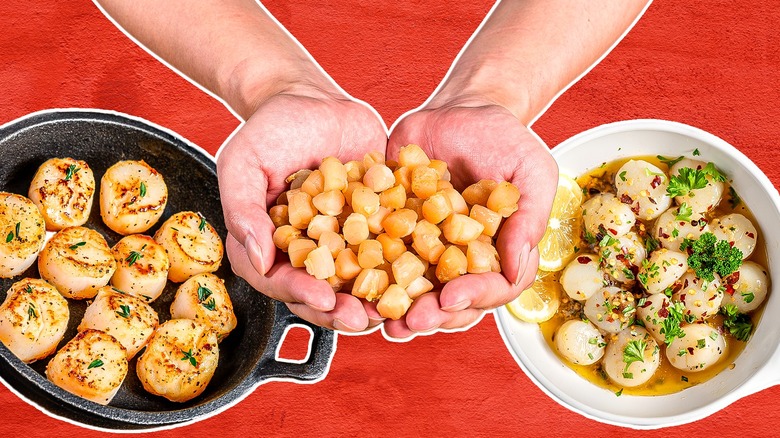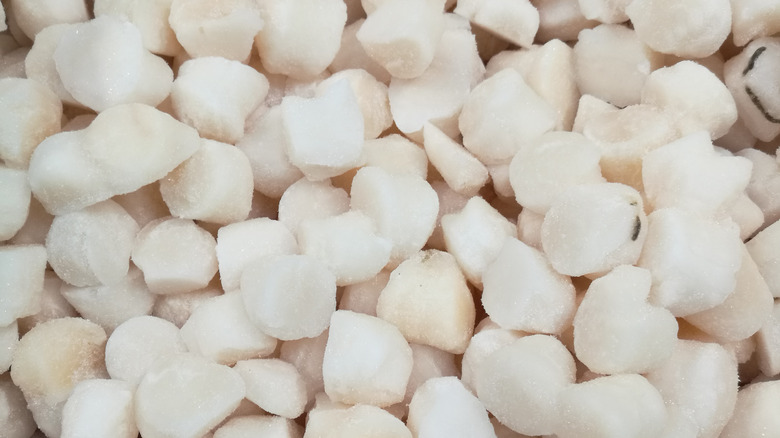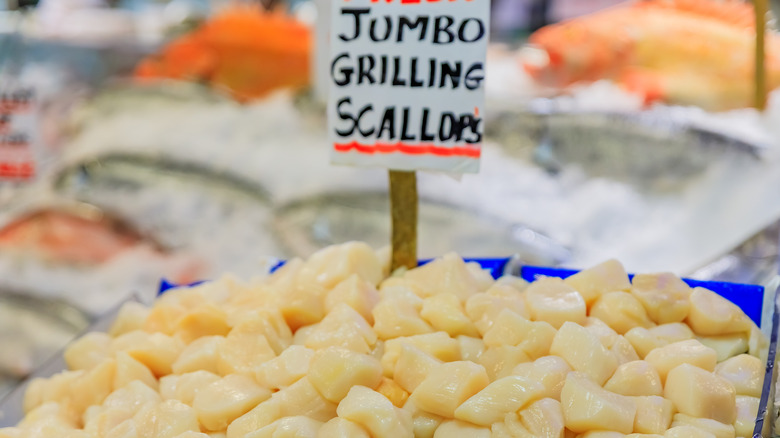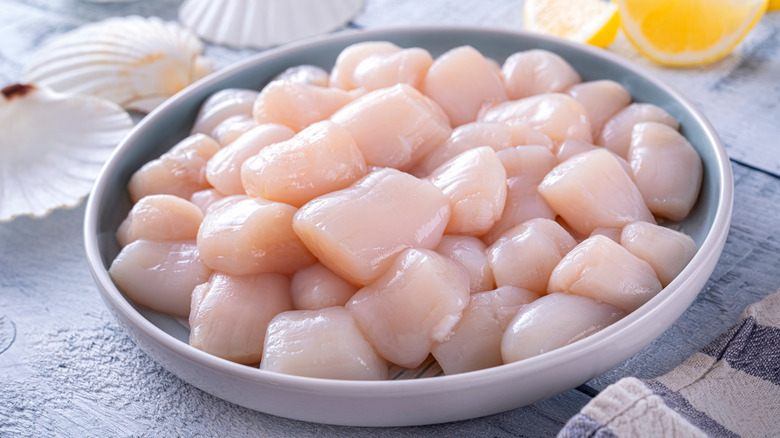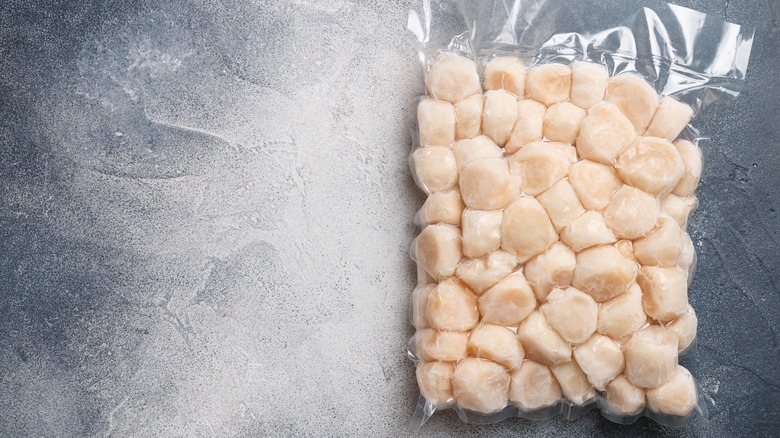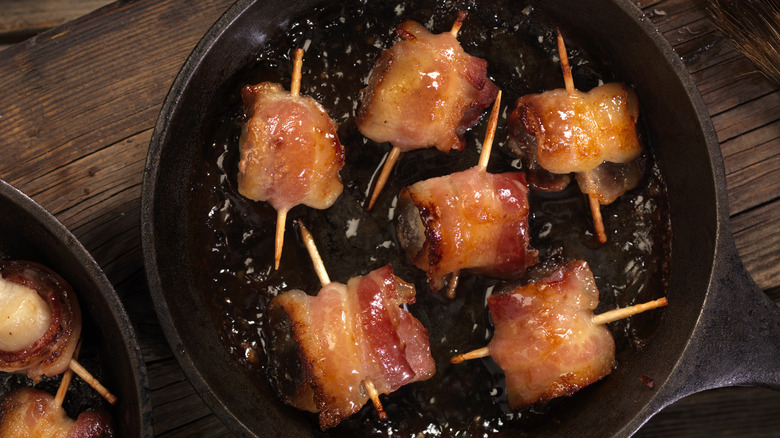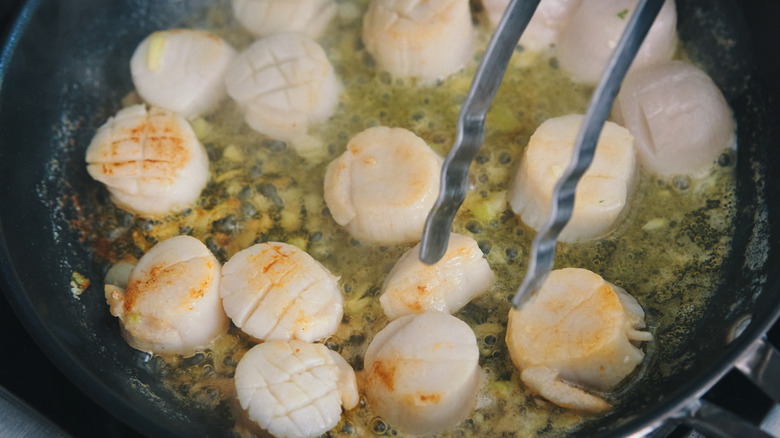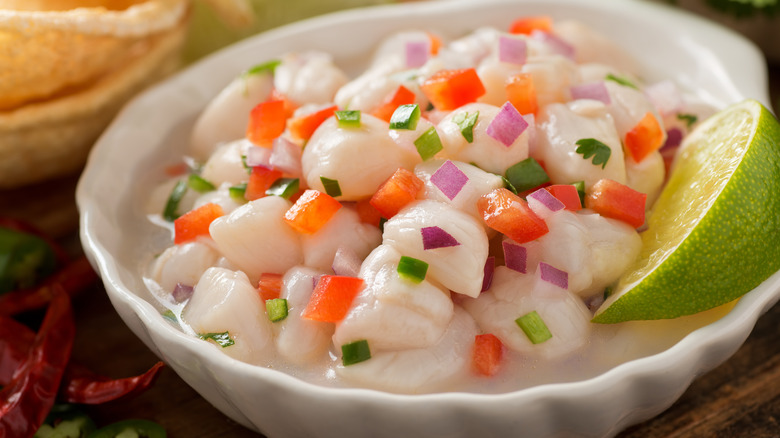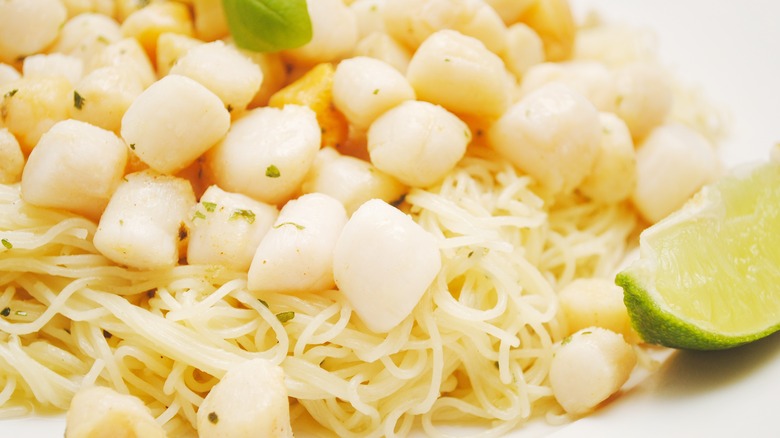10 Common Mistakes To Avoid When Cooking Scallops
Some of the finest foods available grow not on land, but in the sea. Sure, there's a lot to be said for a really great steak, but the same holds true for tuna steaks, lobster, and scallops. That last foodstuff is particularly versatile, delicious, and worthwhile. I should know: My former restaurants hugged the shore of the Bay of Fundy, which borders Maine and the Canadian provinces of Nova Scotia and New Brunswick. Those cold waters produce some of the world's finest scallops, and many of my immediate neighbors worked on the boats that retrieved them. I had the privilege of getting my scallops right from the source, and cooked plenty of them for my own enjoyment as well as for my diners.
If they're prepared properly, scallops provide as good a meal as anyone could wish for. They're even deceptively simple to cook. But you can also get them wrong, and there's nothing sadder than a disappointing scallop. Not to worry, though. I've mustered my expertise to create this list of 10 common mistakes to avoid when cooking scallops. If you learn how to sidestep these pitfalls, you'll get your money's worth every single time.
Not picking the right scallops for the job
There are a lot of ways to differentiate between scallops, including their actual species and the way they're caught. But before we even get to that kind of detail, there's a larger question to address: Do you want bay scallops or sea scallops?
The question comes down to the two key factors of size and flavor. Flavor is on the side of bay scallops; they're noticeably sweeter and more flavorful than their seaborne cousins. The downside is that they're small; it can take 100 of them to make a pound. Sea scallops are larger, and they're the ones you probably think of when you think of scallops in general. They're not quite as sweet as bay scallops, though they're still pretty tasty.
Because of the sharp difference in size, bay and sea scallops aren't interchangeable in any practical way. You'll need to decide which is appropriate for your dish before you go shopping. Tiny bay scallops become overcooked before they ever take a good sear, so they're best used in chowders, soups, sauces, and filled pastas. Sea scallops are your best option when the scallops themselves are the star of the show and the remaining ingredients are just supporting players.
Not holding out for dry scallops
When we say dry scallops, we don't mean the leathery dried ones you find in Asian stores. Those are an interesting product, with many uses — they turn up in Hong Kong's pricey XO sauce, for instance — but they're not what you want for a meal of scallops.
The dry scallops we're talking about may (in fact, should) look slightly moist to the touch, because the distinction of dry-versus-wet scallops comes down to how they're handled. Scallops are described as wet when they're treated with a phosphate bath after being shucked. This helps make the highly perishable shellfish last longer, and as a side benefit (from the seller's perspective), they absorb extra water, becoming heavier. Since they're sold by the pound, that makes them more profitable.
For the buyer, this calculation goes in the opposite direction. You definitely don't want to pay scallop prices for water! Aside from that fundamental downside, wet scallops also won't sear well and the phosphate bath can leave them with a chemical aftertaste. You can usually tell them apart at a glance; wet scallops are unnaturally pale and typically show moisture pooling in the bottom of their packaging. Untreated scallops tend to be off-white, or even pink in color.
Falling for seafood fraud when buying scallops
There's a persistent urban myth that claims scallops are frequently faked by shifty vendors who punch out cookie-cutter rounds of flesh from shark or skate wings. We've never seen a verified case from a reliable source, and think it unlikely — for one thing, shark sells for more than scallops.
This isn't to say that scallops are immune to seafood fraud, of course, just that it takes different forms. An unscrupulous seller might label imported Japanese scallops as wild-caught Alaskan weathervane scallops, for example, or dredged scallops as diver-caught. In either case, you'll pay a premium price for a product that doesn't merit it. There are also outright fake scallops on the market, often sold openly. Typically, they're a form of surimi, or processed fish, just like the "krab" you see at the supermarket. Such "scallops" are easy to tell apart from real scallops because of their perfectly white color, identical size and shape, and the absence of a side muscle. You probably won't see them sold as scallops at retail, but they may turn up in restaurant dishes. Pay close attention to make sure you don't end up with them.
Not removing the side muscle
Most animal life has what are called fast-twitch and slow-twitch muscles. The fast-twitch kind are for bursts of intense activity, and the slow-twitch kind give endurance for long-term activity. Bivalves like muscles and clams aren't known for their activity, but scallops are different. They can actually swim by rapidly opening and closing their shells, which is why their adductor muscle – the part we eat — is so big. That's fast-twitch muscle, and like a chicken's breast, it's tender and succulent. The smaller side muscle, or "catch" muscle, is made of long-twitch fibers; it's meant for holding the shell shut once it's closed (to fend off a predator, for example). It doesn't taste bad, but it's tough and chewy compared to the rest of the scallop.
That's why you should remove that muscle before cooking your scallops. You pay a premium price for them, so you should enjoy a premium dining experience, and chewing something rubbery doesn't fit that description. Don't discard them, though. They can add flavor to stocks, broth, and sauces, and you can simply strain them out before serving.
Not knowing the count sizes used for scallops
Given rising food prices, most of us have become diligent comparison shoppers — but it's not always easy to compare. You might buy cauliflower at Store A, for example, only to discover that the ones at Store B are nearly twice as large and would have been a better buy.
Like many fruits and vegetables, scallops are sold by their "count" size. This is harder to compare to produce: You may not know how many cauliflower are in a case, but the count size for shellfish is almost always shown on the packaging or in advertising. With sea scallops, for example, the most common size is 20/30, meaning you'll get 20 to 30 scallops in every pound. The smaller the number, the larger the scallop.
A pound of scallops is a pound of scallops, regardless of size, but you'll usually pay a premium for jumbo specimens. Larger scallops in the 10/20 size typically cost more, and the huge U-8s (fewer than 8 per pound) are pricier yet. Your recipe may specify which size to use; otherwise it's up to you to decide whether fewer, larger scallops make sense in your dish. Other factors can affect scallops' price, but their size is a key part of the equation when you're comparison shopping. Learning to take it seriously is important.
Not thawing your scallops correctly
All fish are highly perishable, and shellfish are no exception — some would argue they're even more perishable than regular fish. Scallops are often sold frozen, as a way to work around that perishability. Blast-freezing them as soon as they're harvested preserves them at the peak of freshness, so unless you're buying yours right from the boat, frozen scallops are anything but a compromise.
The only issue with frozen scallops is that you need to thaw them properly so they'll retain their tip-top quality. The three main options are thawing them in your microwave, in a cold water bath, or in your refrigerator. The microwave is your nuclear option, for when you have frozen scallops and need to cook them right this minute. This risks cooking your expensive scallops at the edges, though, making them rubbery.
A cold water bath takes longer. It's still quick enough that you can thaw scallops in time for that night's meal, but it's at the risk of them absorbing water and becoming soggy. Your best option is thawing scallops overnight (or all day) in your refrigerator. This way, your scallops remain at a food safe temperature until you're ready to cook them, and retain all their best qualities. Just blot them dry with a paper towel and use them as directed in your favorite recipe.
Overcooking your scallops
We all have that one friend who "just knows" when a steak is done by how it feels to the touch. Sometimes they're even right. But if all those helpful rules of thumb fail, you can always just stick a thermometer into a steak. With scallops, the (ahem) stakes are higher. Not only are they an expensive ingredient, but they cook very quickly. Worse yet, over-cooking leaves them dry and rubbery, rather than tender and sweet, and their size and shape make them impractical candidates for an instant-read thermometer.
You need good technique and a bit of practice to know when scallops are done. To start with, make sure your scallops are as dry as you can get them and your pan is well heated. They're done when they're well-seared on each side — it only takes 2 to 3 minutes — and there's no line of paler flesh visible in the middle. The outer edges should feel firm to your fingertips when you squeeze them, but the scallop as a whole should still feel soft in the middle. If you're unsure, sacrifice one in the name of certainty and cut it in half. If the middle is opaque but still soft, they're done.
Not getting a good sear
Scallops are high in glycogen, a form of sugar used to fuel muscle activity. That's the source of their distinctively sweet and nutty flavor, and it also helps them brown quickly and flavorfully. While scallops are ideally suited for searing, success isn't guaranteed. To begin with, you want to use sea scallops for searing (tiny bay scallops will overcook before they take a good sear). Blot them as dry as possible with paper towels, and leave them uncovered in your fridge for a few hours if you can spare the time; the air in your fridge is very dry, and will evaporate some additional moisture.
At this point, you should get the pan ready for your scallops. It should be well above medium temperature when you add your oil or butter; the oil should be shimmering or the butter should stop foaming before you put that first scallop in the pan. Lay them in one at a time, flat sides facing down, with plenty of room between scallops (work in batches, rather than crowding the pan). Let them sit undisturbed for 2 to 3 minutes, until the scallop is seared well enough to easily release from the pan, then turn them for another 2 to 3 minutes. Scallops larger than the common 20/30 size may take longer.
Not brining or marinating your scallops
Since dry scallops are better than wet, as we've already established, the idea of brining or marinating them might strike you as counter-intuitive. If dry is best, surely brining them is a bad idea? Well, no. Salt draws moisture from foods, so if wet scallops are all you can find, brining them will remove much of that excess moisture and the phosphates that cause the unpleasant chemical aftertaste many people dislike. With dry scallops, brining can improve texture and effectively season them. It's a simple step, but it's sure to make your scallops taste better.
Marinades can also help your scallops shine. A milk marinade, for example, can ameliorate any fishy smell if your scallops aren't at their peak of freshness. Marinades with herbs, spices, and citrus juice or vinegar can add complementary flavors that bring out the scallops' sweetness. The ultimate version of this is scallop ceviche, which needs no cooking at all because the acidity of the marinade does the "cooking" for you.
Getting stuck on seared scallops and ignoring other preparations
We all have our favorite ways of preparing certain foods. You may always sear your ribeyes in cast iron, or fry your catfish in cornmeal with a vibrant tomato sauce. Pan-searing your scallops is an equally iconic preparation method. It's great, it's delicious, it's quick — we get it. Whatever makes you happy.
But there are lots of other ways to cook scallops that are also excellent, and if you never get past pan-searing, you'll miss out on them. Have you ever grilled your scallops, or skewered them over the coals of a campfire? Have you broiled them in your oven? If you're already having a fish fry, adding a few breaded scallops to the mix will elevate the entire meal. Consider also the wide world of seafood-based pasta dishes and classic, spicy fish stews like cioppino, where smaller bay scallops have their moment to shine. You'll get more bang for your seafood buck using scallops as the "halo" ingredient that elevates the rest of the dish, as opposed to being the centerpiece the whole meal revolves around.
